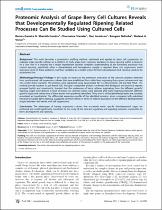| dc.contributor.author | Sharathchandra, Ramaschandra G. | |
| dc.contributor.author | Stander, Charmaine | |
| dc.contributor.author | Ndimba, Bongani | |
| dc.date.accessioned | 2023-05-22T13:18:50Z | |
| dc.date.available | 2023-05-22T13:18:50Z | |
| dc.date.issued | 2011 | |
| dc.identifier.citation | Sharathchandra, R. G. et al. (2011). Proteomic analysis of grape berry cell cultures reveals that developmentally regulated ripening related processes can be studied using cultured cells. PLoS ONE, 6 (2), | e14708. https://doi.org/10.1371/journal.pone.0014708 | en_US |
| dc.identifier.issn | 1932-6203 | |
| dc.identifier.uri | https://doi.org/10.1371/journal.pone.0014708 | |
| dc.identifier.uri | http://hdl.handle.net/10566/8928 | |
| dc.description.abstract | This work describes a proteomics profiling method, optimized and applied to berry cell suspensions to evaluate organ-specific cultures as a platform to study grape berry ripening. Variations in berry ripening within a cluster(s) on a vine and in a vineyard are a major impediment towards complete understanding of the functional processes that control ripening, specifically when a characterized and homogenous sample is required. Berry cell suspensions could overcome some of these problems, but their suitability as a model system for berry development and ripening needs to be established first. | en_US |
| dc.language.iso | en | en_US |
| dc.publisher | Public Library of Science | en_US |
| dc.subject | Biotechnology | en_US |
| dc.subject | Cell cultures | en_US |
| dc.subject | Proteomics | en_US |
| dc.subject | Crops | en_US |
| dc.subject | Agriculture | en_US |
| dc.subject | Grapes | en_US |
| dc.title | Proteomic analysis of grape berry cell cultures reveals that developmentally regulated ripening related processes can be studied using cultured cells | en_US |
| dc.type | Article | en_US |

